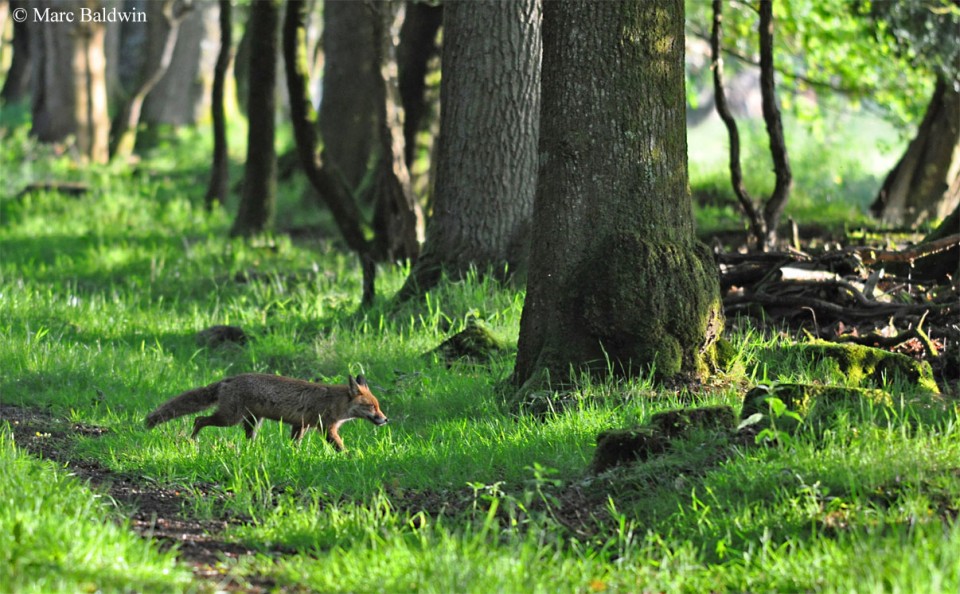Red Fox Habitat
Red foxes thrive in almost all habitats because they are relatively unspecialised in their way of life. Consequently, foxes have been found at most altitudes, from sea level up to 3000m (almost 10,000 ft) and in most terrestrial environments on Earth; their distribution and abundance is a result of the availability of food and suitable breeding sites. Red foxes are generally a species of, and do best in, mixed landscapes consisting of scrub, woodland and farmland.
Red foxes are found in dense woodland and plantations, on moorland, coastal dunes and above the tree-line in mountain ranges, but the reduction in (or high seasonality of) food supply in such places tends to mean they are less abundant in such habitats. Indeed, it is widely held that the clearance of woodland to make way for agricultural land created very favourable conditions for Red foxes and, in conjunction with the introduction of game species (e.g. brown hare, rabbits, pheasant, domestic fowl, etc.) to these habitats, is largely responsible for the rapid colonization of Eurasia and North America by this species.

In 1980, M.A.F.F. biologist Huw Gwyn Lloyd wrote of the habitat of the fox:
“Areas least suitable for foxes, whether harassed or not, would have some or all of the following characteristics; flat, open country; few woodlands or very open deciduous woodland; neat or simple field boundaries (fences or ditches, e.g.); no scrub or uncultivatable land; large field, mainly arable and a high water table.”
In plantations, foxes prefer a mosaic of close-canopy conifers (which offers shelter) at the pre-thicket stage (which provides food) – once the canopy has completely closed, the productivity of the plantation declines and, if used by foxes, it now serves only as a denning or daytime resting site. In general, foxes tend to use mature conifer plantations as daytime resting sites, moving into nearby open areas to feed.
The use of the habitat will also vary seasonally. In Tuscany, central Italy, Paolo Cavallini and Sandro Lovari found that foxes showed a preference for marquis (scrubwood) habitats, meadows and pine forests, with the former being most (and the latter least) used during cold seasons. There are many accounts of foxes focusing more time and energy on coastal and dune habitats during seabird breeding seasons. Similarly, observations by David Macdonald in Oxford have shown that on warm, damp nights foxes can spend several hours searching livestock fields for worms, while in hot, dry conditions they focus their attention more heavily on small mammals in woodland or crop stands.
Foxes thrive in many urban areas and it is in streets, back gardens and parks that most people will encounter a fox nowadays. Indeed, Mark Cardwine gives the Red fox the accolade of ‘most urbanized canid’ in his 2007 book, Animal Records, having adapted to life in towns and cities more successfully than any other member of the dog family (presumably excluding domestic pooches). Under the definition argued by Robert Francis and Michael Chadwick in their 2011 paper to Applied Geography, the Red fox is a truly synurbic species; their population densities are higher in urban areas than in rural habitats. As a testament to their comfort around urbanization, a fox has even been reported to have raised a litter of cubs in the 54,000-seater Yankee Stadium in New York. In Britain, however, foxes tend to do best in middle-class suburbs with low density housing where most houses are privately-owned and accompanied by a reasonable size garden that is largely free of disturbance.
In a 1986 paper to the Journal of Animal Ecology, Bristol University biologists Stephen Harris and Jeremy Rayner suggested that, in Britain, the boom in private house construction after 1930, which occurred as increased mobility allowed people to live and work further apart, led to a proliferation of privately owned three-bedroom semi-detached houses that appear to offer foxes just what they need. This association with houses with sizeable gardens probably explains why there was historically a strong latitudinal and longitudinal correlation in fox distribution in English towns and cities - foxes were more common in conurbations in southern England than in northern and eastern regions. More recently, however, data from the Foxes Live survey (more on this in Abundance) suggests this is no longer the case and that foxes are now widespread in Britain, albeit probably with lower densities in northern and eastern areas than in southern towns and cities.

Contrary to popular misconception, urban foxes aren’t the preserve of Britain – they’re now present in most large European cities and are also found in cities across America (including Los Angeles, New York and Washington), Australia (Adelaide, Brisbane, Canberra, Melbourne and Sydney), Canada (Toronto) and Japan (Hokkaido and Sapporo). Despite being called urban foxes, it is a misrepresentative to think that these animals are confined to built-up areas. Tracking studies by Bristol University have shown that urban foxes move freely into and out of the city while feeding and looking for mates; some rural-based animals were tracked moving into the city at night to feed. Similarly, in a 1982 paper on the distribution and ecology of urban foxes, Oxford University zoologists David Macdonald and Malcolm Newdick found that dispersing foxes moved back and forth between town and country, and they concluded:
“A categorical division between rural and urban foxes was found to be without foundation. The proportion of urban and rural habitats embraced within the home-ranges of foxes varied from one to the next, and foxes moved readily between them.”
A recent review of Red fox distribution reported that there are 'significant numbers' of foxes living in an estimated 114 cities across the globe, including 56 in the UK, 40 in mainland Europe, 10 in the USA and six in Australia. For more information about when and why foxes colonised our towns and cities, please see the associated QAs.